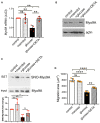S-Nitrosylation of RhoGAP Myosin9A Is Altered in Advanced Diabetic Kidney Disease
- PMID: 34336885
- PMCID: PMC8316719
- DOI: 10.3389/fmed.2021.679518
S-Nitrosylation of RhoGAP Myosin9A Is Altered in Advanced Diabetic Kidney Disease
Abstract
The molecular pathogenesis of diabetic kidney disease progression is complex and remains unresolved. Rho-GAP MYO9A was recently identified as a novel podocyte protein and a candidate gene for monogenic FSGS. Myo9A involvement in diabetic kidney disease has been suggested. Here, we examined the effect of diabetic milieu on Myo9A expression in vivo and in vitro. We determined that Myo9A undergoes S-nitrosylation, a post-translational modification dependent on nitric oxide (NO) availability. Diabetic mice with nodular glomerulosclerosis and severe proteinuria associated with doxycycline-induced, podocyte-specific VEGF 164 gain-of-function showed markedly decreased glomerular Myo9A expression and S-nitrosylation, as compared to uninduced diabetic mice. Immortalized mouse podocytes exposed to high glucose revealed decreased Myo9A expression, assessed by qPCR, immunoblot and immunocytochemistry, and reduced Myo9A S-nitrosylation (SNO-Myo9A), assessed by proximity link assay and biotin switch test, functionally resulting in abnormal podocyte migration. These defects were abrogated by exposure to a NO donor and were not due to hyperosmolarity. Our data demonstrate that high-glucose induced decrease of both Myo9A expression and SNO-Myo9A is regulated by NO availability. We detected S-nitrosylation of Myo9A interacting proteins RhoA and actin, which was also altered by high glucose and NO dependent. RhoA activity inversely related to SNO-RhoA. Collectively, data suggest that dysregulation of SNO-Myo9A, SNO-RhoA and SNO-actin may contribute to the pathogenesis of advanced diabetic kidney disease and may be amenable to therapeutic targeting.
Keywords: MYO9A; RhoA; S-nitrosylation; actin; cell cross-talk; diabetic kidney disease.
Copyright © 2021 Li, Veron and Tufro.
Conflict of interest statement
The authors declare that the research was conducted in the absence of any commercial or financial relationships that could be construed as a potential conflict of interest.
Figures






Similar articles
-
Rho-GTPase Activating Protein myosin MYO9A identified as a novel candidate gene for monogenic focal segmental glomerulosclerosis.Kidney Int. 2021 May;99(5):1102-1117. doi: 10.1016/j.kint.2020.12.022. Epub 2021 Jan 4. Kidney Int. 2021. PMID: 33412162 Free PMC article.
-
Assembly of the Non-Canonical Myo9a-RhoGAP and RhoA·GDP Transition State Complex in the Presence of MgF3.Protein J. 2021 Dec;40(6):842-848. doi: 10.1007/s10930-021-10027-4. Epub 2021 Oct 28. Protein J. 2021. PMID: 34709522
-
Podocyte-specific VEGF-a gain of function induces nodular glomerulosclerosis in eNOS null mice.J Am Soc Nephrol. 2014 Aug;25(8):1814-24. doi: 10.1681/ASN.2013070752. Epub 2014 Feb 27. J Am Soc Nephrol. 2014. PMID: 24578128 Free PMC article.
-
Protein S-Nitrosylation: Determinants of Specificity and Enzymatic Regulation of S-Nitrosothiol-Based Signaling.Antioxid Redox Signal. 2019 Apr 1;30(10):1331-1351. doi: 10.1089/ars.2017.7403. Epub 2018 Jan 10. Antioxid Redox Signal. 2019. PMID: 29130312 Free PMC article. Review.
-
Pathogenesis of the podocytopathy and proteinuria in diabetic glomerulopathy.Curr Diabetes Rev. 2008 Feb;4(1):39-45. doi: 10.2174/157339908783502370. Curr Diabetes Rev. 2008. PMID: 18220694 Review.
Cited by
-
Podocyte VEGF-A Knockdown Induces Diffuse Glomerulosclerosis in Diabetic and in eNOS Knockout Mice.Front Pharmacol. 2022 Feb 23;12:788886. doi: 10.3389/fphar.2021.788886. eCollection 2021. Front Pharmacol. 2022. PMID: 35280251 Free PMC article.
-
Distinct types of protein modifications in diabetic endothelial dysfunction.Cardiovasc Diabetol. 2025 Jul 14;24(1):287. doi: 10.1186/s12933-025-02836-z. Cardiovasc Diabetol. 2025. PMID: 40660266 Free PMC article. Review.
-
Nitric-Oxide-Mediated Signaling in Podocyte Pathophysiology.Biomolecules. 2022 May 25;12(6):745. doi: 10.3390/biom12060745. Biomolecules. 2022. PMID: 35740870 Free PMC article. Review.
-
Redox regulation in diabetic kidney disease.Am J Physiol Renal Physiol. 2023 Aug 1;325(2):F135-F149. doi: 10.1152/ajprenal.00047.2023. Epub 2023 Jun 1. Am J Physiol Renal Physiol. 2023. PMID: 37262088 Free PMC article. Review.
References
Grants and funding
LinkOut - more resources
Full Text Sources
Miscellaneous

